- 1AI中的对齐方式_ai视图对齐可以对齐什么
- 2docker容器:安装 / 导入镜像 / 共享内核 / docker commit构建镜像_docker是如何共享kernel
- 3Mac版微信3.0.0变身刷朋友圈(摸鱼)神器,教你如何下载_mac微信 朋友圈 摸鱼
- 4VIT 三部曲 -1 Transformer_transformer[1]-vit
- 5windows查看后台执行中的python或bat脚本_windows 如何查看python当前运行什么脚本
- 6vue elementui动态增加列表表单_
- 7Windows的命令行怎么支持通配符
- 888E1111部分解读_88e1111 config配置详解
- 9把 B 站的视频弹幕搬到小程序中,这项技术可以轻松搞定_b站视频连接跳小程序
- 10顶刊TPAMI 2023!Food2K:大规模食品图像识别
[LeetCode 145] Binary Tree Postorder Traversal_node m and n are in a binary tree a.m is right si
赞
踩
Question:
Given a binary tree, return the postorder traversal of its nodes' values.
For example:
Given binary tree {1,#,2,3},
1
\
2
/
3
return [3,2,1]- 1
- 2
- 3
- 4
- 5
- 6
- 7
- 8
- 9
- 10
Approach #1 Recursive [Accepted]
Detail Explanation
The first method to solve this problem is using recursive.
This is the classical method and straightforward.
we can define a helper function to implement recursion.
The java code is as follows:
Java
public class Solution {
public List<Integer> postorderTraversal(TreeNode root) {
List<Integer> res = new ArrayList<>();
helper(root, res);
return res;
}
public void helper(TreeNode root, List<Integer> res) {
if (root != null) {
if (root.left != null) {
helper(root.left, res);
}
if (root.right != null) {
helper(root.right, res);
}
res.add(root.val);
}
}
}

- 1
- 2
- 3
- 4
- 5
- 6
- 7
- 8
- 9
- 10
- 11
- 12
- 13
- 14
- 15
- 16
- 17
- 18
- 19
- 20
Complexity Analysis
Time complexity : O(n)
O(n) . The time complexity is O(n)O(n) because the recursive function is T(n)=2∗T(n/2)+1T(n)=2∗T(n/2)+1 .Space complexity : The worst case is O(n)
O(n) , and the average case is O(log(n))O(log(n)) where nn is number of nodes.
a lot of people will have the question, why the worst case is O(n)O(n) ?
it is because the space complexity is related to the height of the tree when the tree is balanced, the height is O(log(n))O(log(n)) , the worst case is O(n)O(n) .
Approach #2 Iterating method using Stack
First Attempt: [Wrong Answer]
As other people, the first time do this question,
The first thing comes to my mind is
it is similar to the iterative method we did for Preorder Traversal and Inorder Traversal.
Here is my first attempt java code:
Java
public class Solution {
public List<Integer> postorderTraversal(TreeNode root) {
List<Integer> res = new ArrayList<>();
Stack<TreeNode> stack = new Stack<>();
TreeNode curr = root;
while (curr != null) {
stack.push(curr);
if (curr.right != null) {
stack.push(curr.right);
}
if (curr.left != null) {
curr = curr.left;
}
if (curr == null && !stack.isEmpty()) {
curr = stack.pop();
res.add(curr.val);
}
}
return res;
}
}
- 1
- 2
- 3
- 4
- 5
- 6
- 7
- 8
- 9
- 10
- 11
- 12
- 13
- 14
- 15
- 16
- 17
- 18
- 19
- 20
- 21
- 22
- 23
- 24
- 25
- 26
why is doesn’t work?
Here is an Example:
1
/ \
2 3
/ \
4 5
Initial status: Stack[], res[], curr = 1;
->: Push 1 into stack, Stack[1];
->: Push 3 into stack, Stack[1,3], curr = 2;
->: Push 2 into stack, Stack[1,3,2];
->: Push 5 into stack, Stack[1,3,2,5], curr = 4;
->: Push 4 into stack, Stack[1,3,2,5,4];
->: Push 4 into stack, Stack[1,3,2,5,4], curr = null;
->: Pop the Stack and add the poped val into res, res[4];
->: Pop the Stack and add the poped val into res, res[4,5];
->: Pop the Stack and add the poped val into res, res[4,5,2];
at this step, we find that the current node is updated by 2 which is a visited node.
if we continue, we will loop in the subtree [2,4,5] forever.

- 1
- 2
- 3
- 4
- 5
- 6
- 7
- 8
- 9
- 10
- 11
- 12
- 13
- 14
- 15
- 16
- 17
- 18
- 19
- 20
- 21
How to solve?
we have to know that the poped node is visited or not?
[ Method 1 ]: Using Two Stacks
Detail Explanation
First, let us do it in an easier method. Using two stacks.
Postorder traversal is like the Hanoi game. The problem is become how to design a strategy that makes sure the node’s order poped from stack is the post traversal order using 2 stacks?
You can try yourself as a practice.
Here is the strategy:
Step1. Initialize 2 stacks, Stack1 and Stack2;
Step2. Push current root into first stack;
Step3. While Stack1 is not empty
a pop Stack1 and push the poped node into stack2;
b Push popped node’s left into Stack1 if it is not NULL;
Push popped node’s right into Stack1 if it is not NULL;
Step4. While Stack2 is not empty
add the poped node into result list;
Here is an Example:
1
/ \
2 3
/ \
4 5
->1: Stack1[], Stack2[];
->2: Push the root node into Stack1,
Stack1[1]
Stack2[];
->3: the Stack1 is not empty so we go into the loop
step 3.a: Stack1[], Stack2[1];
step 3.b: Stack1[2,3], Stack2[1];
->3: the Stack1 is not empty so we continue the loop
step 3.a: Stack1[2], Stack2[1, 3];
->3: the Stack1 is not empty so we continue the loop
step 3.a: Stack1[], Stack2[1,3,2];
step 3.b: Stack1[4, 5], Stack2[1,3,2];
->3: the Stack1 is not empty so we continue the loop
step 3.a: Stack1[4], Stack2[1,3,2,5];
->3: the Stack1 is not empty so we continue the loop
step 3.a: Stack1[], Stack2[1,3,2,5,4];
->3: the Stack1 is empty, quit the loop go to step4
->4: pop the Stack2 one by one
the result is [4,5,2,3,1]

- 1
- 2
- 3
- 4
- 5
- 6
- 7
- 8
- 9
- 10
- 11
- 12
- 13
- 14
- 15
- 16
- 17
- 18
- 19
- 20
- 21
- 22
- 23
- 24
- 25
- 26
- 27
- 28
A comment
If you pay attention, you will find that Stack1 containing all the unprocessed node, and Stack2 is for the processed node.
When we finish processing the node, pop it from Stack1 and push it into Stack2
Java
class Solution {
public List<Integer> postorderTraversal(TreeNode root) {
List<Integer> res = new ArrayList<>();
Stack<TreeNode> stack1 = new Stack<>();
Stack<TreeNode> stack2 = new Stack<>();
if (root == null) {
return res;
}
stack1.push(root);
while (!stack1.isEmpty()) {
TreeNode temp = stack1.pop();
stack2.push(temp);
if (temp.left != null)
stack1.push(temp.left);
if (temp.right != null)
stack1.push(temp.right);
}
while (!stack2.isEmpty()) {
TreeNode temp = stack2.pop();
res.add(temp.val);
}
return res;
}
}

- 1
- 2
- 3
- 4
- 5
- 6
- 7
- 8
- 9
- 10
- 11
- 12
- 13
- 14
- 15
- 16
- 17
- 18
- 19
- 20
- 21
- 22
- 23
- 24
- 25
- 26
- 27
- 28
- 29
Complexity Analysis
Time complexity : O(n)
O(n) Space complexity : O(n)
O(n) .
[ Method 2 ]: Using One Stack
Detail Explanation
the main problem is when we visit a TreeNode, we have to know that if the TreeNode has been visited or not? and how to check the visited TreeNode using just one stack?
The strategy is as follows:
Yu’s Coding Garden
Step1: Initializing, i.e, stack and result list
Step2: Push the root node into the stack.
Step3: while the stack is not empty, do:
if
a. the top node is a leaf node (no left && right children),
pop it.
or if the top node has been visited,
pop it.
(here we use a signed head to show the latest popped node, if the top node has child = the latest popped node, either left or right, it must have been visited.)
else
b. push the right child of the top node (if exists)
c. push the left child of the top node (if exists)
Step4: return result list;- 1
- 2
- 3
- 4
- 5
- 6
- 7
- 8
- 9
- 10
- 11
- 12
- 13
Here is an Example:
1
/ \
2 3
/ \ /
4 5 6
->1: Stack[]
->2: Push the root node into Stack,
Stack[1]
->3: the Stack is not empty so we go into the loop and the top node is 1;
step 3.b: push 3 into stack, Stack[1,3]
step 3.c: push 2 into stack, Stack[1,3,2]
->3: the Stack is not empty so we continue the loop and the top node is 2;
step 3.b: push 5 into stack, Stack[1,3,2,5]
step 3.c: push 4 into stack, Stack[1,3,2,5,4]
->3: the Stack is not empty so we continue the loop and the top node is 4;
step 3.a: node 4 is the leaf node so pop the stack, Stack[1,3,2,5];
add node 4 into result list, res[4];
update current node as 4;
->3: the Stack is not empty so we continue the loop and the top node is 5
step 3.a: node 5 is the leaf node so pop the stack, Stack[1,3,2];
add node 5 into result list, res[4,5];
update current node as 5;
->3: the Stack is not empty so we continue the loop and the top node is 2
//Please pay attention to this step, it helps us to find the visited node
step 3.a: top node is 2 and current node is 5
so node 2 is the visited node.
pop stack, Stack[1,3];
add node 2 into result list, res[4,5,2];
update current node as 2;
->3: the Stack is empty so we continue the loop and the top node is 3
step 3.c push 6 into stack, Stack[1,3,6];
->3: the Stack is not empty so we continue the loop and the top node is 6
step 3.a node 6 is the leaf node so we pop the stack, Stack[1,3];
add node 6 into result list, res[4,5,2,6];
update the current node as 6;
->3: the stack is not empty so we continue the loop and the top node is 3
step 3.a node 3 is the visited node, pop the stack, Stack[1];
add node 3 into result list, res[4,5,2,6,3];
update current node as 3;
->3: the stack is not empty so we continue the loop and the top node is 1
step 3.a node 1 is the visited node, pop the stack, Stack[];
add node 1 into result list, res[4,5,2,6,3,1];
update current node as 1;
->4:
the result is res[4,5,2,6,3,1];

- 1
- 2
- 3
- 4
- 5
- 6
- 7
- 8
- 9
- 10
- 11
- 12
- 13
- 14
- 15
- 16
- 17
- 18
- 19
- 20
- 21
- 22
- 23
- 24
- 25
- 26
- 27
- 28
- 29
- 30
- 31
- 32
- 33
- 34
- 35
- 36
- 37
- 38
- 39
- 40
- 41
- 42
- 43
- 44
- 45
- 46
- 47
- 48
- 49
A comment
Pay attention that when we pop the stack?<br>
1) when the node is the leaf child;
2) when the node has been visited, but how can we know it?
Ans: we define 2 pointers, top which points to the top node on the stack;
head pointer point to the latest poped node.
if the head is the child of the top node, the top has been visited.- 1
- 2
- 3
- 4
- 5
- 6
Java
class Solution {
public List<Integer> postorderTraversal(TreeNode root) {
List<Integer> res = new ArrayList<>();
Stack<TreeNode> stack = new Stack<>();
if (root == null)
return res;
stack.push(root);
TreeNode head = root;
while (!stack.isEmpty()) {
TreeNode top_Stack = stack.peek();
if ((top_Stack.left == null && top_Stack.right == null) || top_Stack.right == head || top_Stack.left == head) {
res.add(top_Stack.val);
stack.pop();
head = top_Stack;
} else {
if (top_Stack.right != null)
stack.push(top_Stack.right);
if (top_Stack.left != null)
stack.push(top_Stack.left);
}
}
return res;
}
}

- 1
- 2
- 3
- 4
- 5
- 6
- 7
- 8
- 9
- 10
- 11
- 12
- 13
- 14
- 15
- 16
- 17
- 18
- 19
- 20
- 21
- 22
- 23
- 24
- 25
- 26
Complexity Analysis
Time complexity : O(n)
O(n) .Space complexity : O(n)
O(n) .
Video Explanation for Using One Stack and Two Stack Methods
Iterative Method for Postorder Traversal
Approach #3 Morris Traversal [Accepted]
Detail Explanation
Morris Method to implement postorder traversal is a little tricky, and it is different from the Preorder Traversal and Inorder Traversal.
Moreover, this method needs to define a reverse function to help us to get the node’s value in post order.
This method we have to use a new data structure Threaded Binary Tree [Threaded binary tree]
(https://en.wikipedia.org/wiki/Threaded_binary_tree)
and the strategy is as follows:
Step1: Initialize a Temporary TreeNode as the temp, temp.left = root, result list res[];
Step2: set current node as temp;
step3: while the curr is not NULL
a: if current node.left is NULL
set current node as current.right;
b: find the right most node in current left subtree as Predecessor Node;
c: IF (Predecessor Node.right child is NULL)
Set Predecessor Node.right as current node;
update current node as current node's left child;
ELSE (Predecessor Node.right child is not null, curr actually)
set Prodecessor Node's right as NULL;
using the reverse function which output is the reverse order of Nodes from curr.left to predecessor node;
add the output of reverse function into result list;
update curr as curr.right;
Step4: Back to Step3;
- 1
- 2
- 3
- 4
- 5
- 6
- 7
- 8
- 9
- 10
- 11
- 12
- 13
- 14
- 15
- 16
For Example:
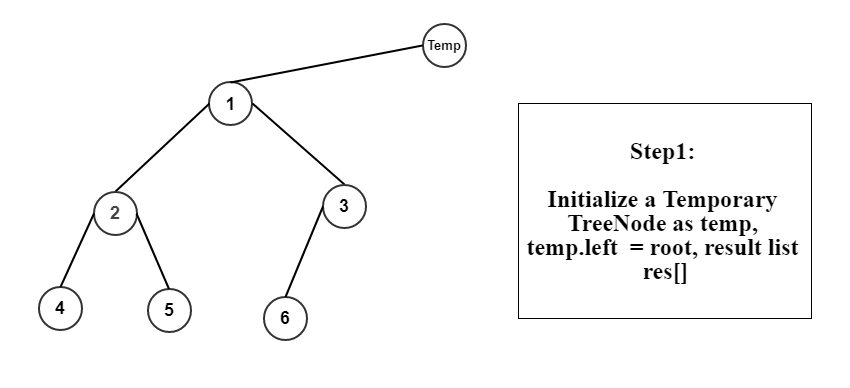
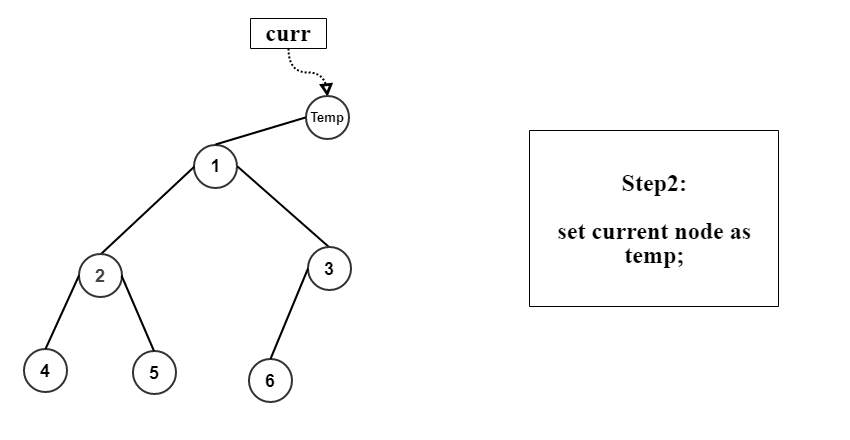
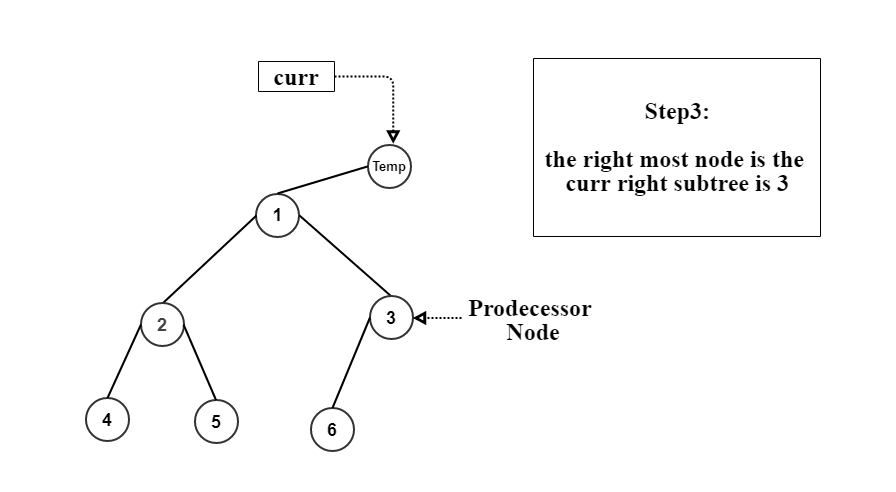
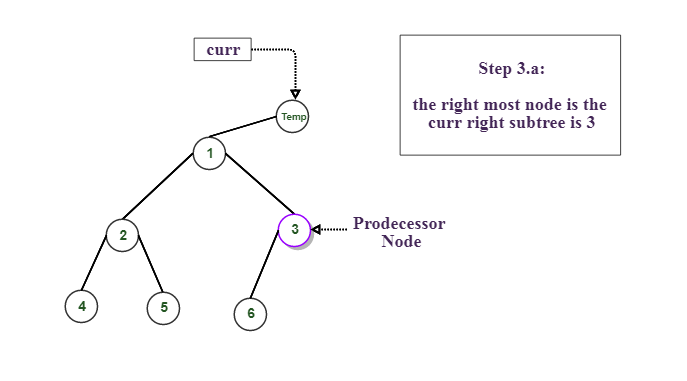
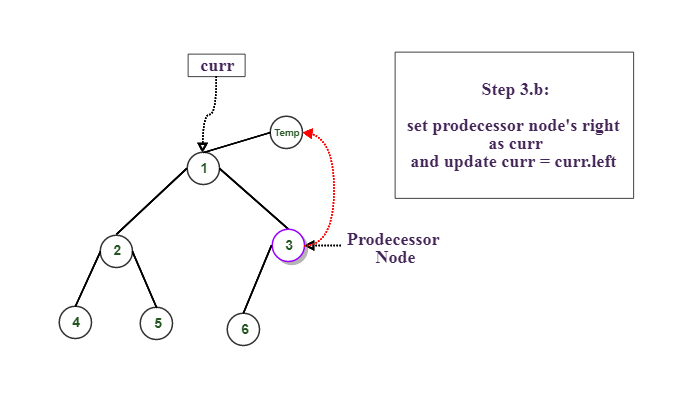
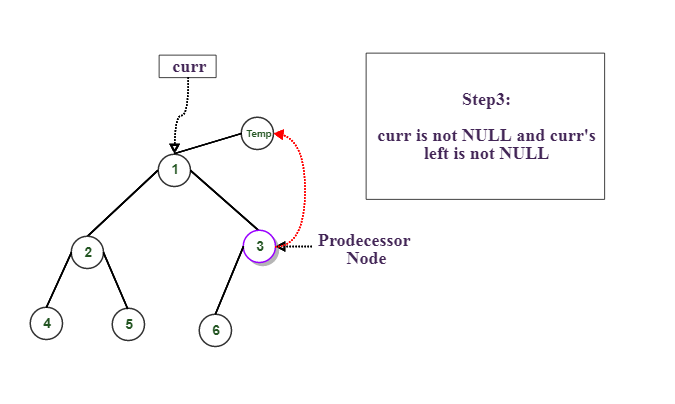
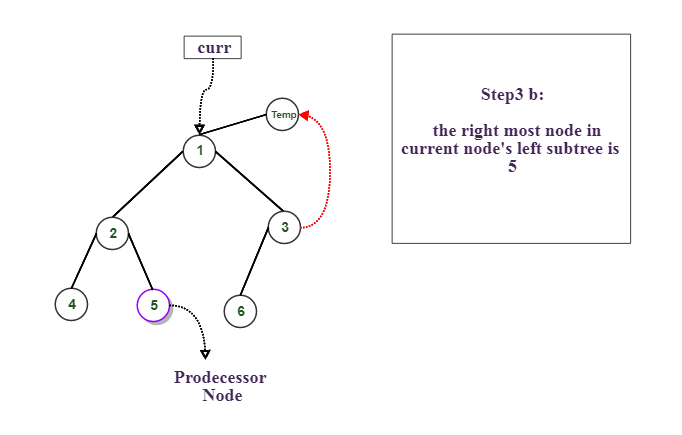
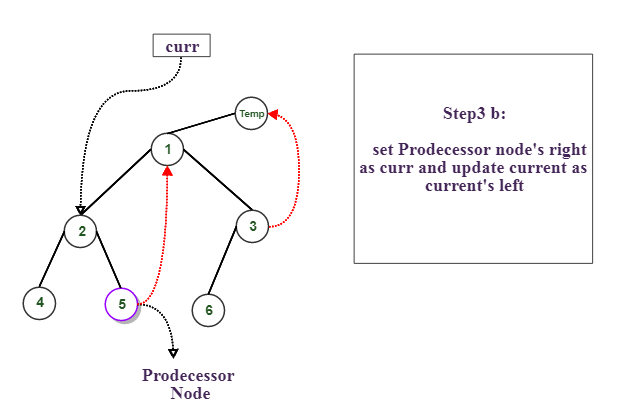
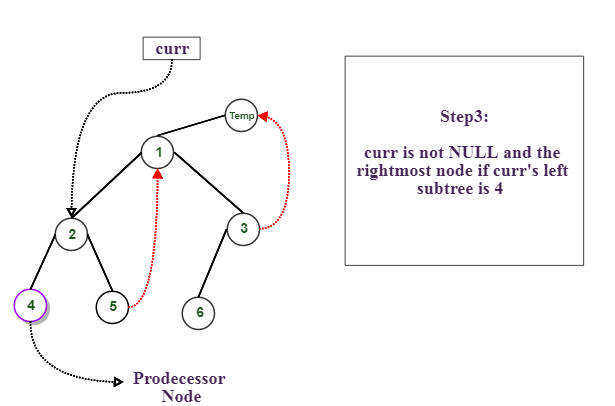
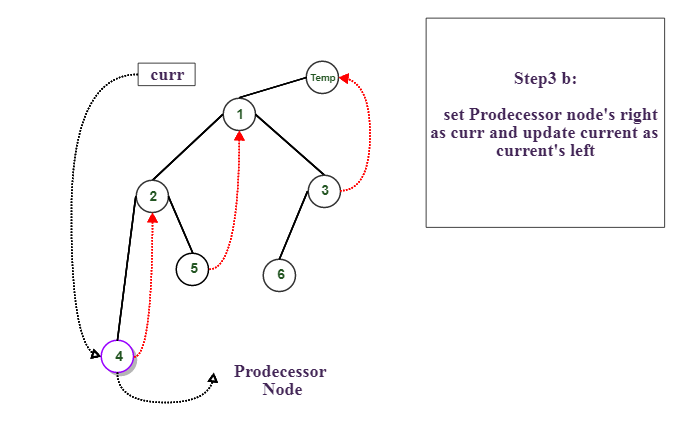
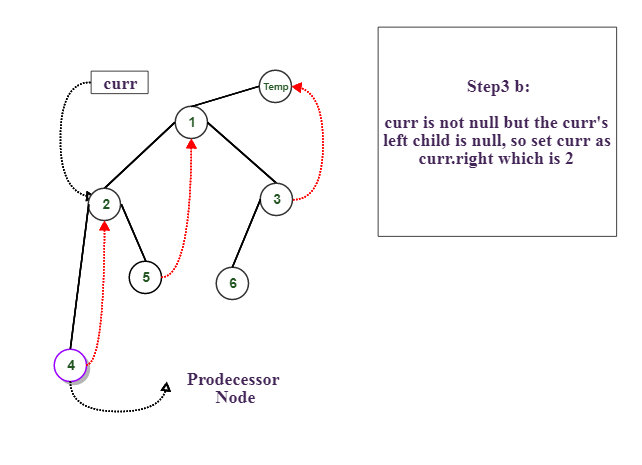
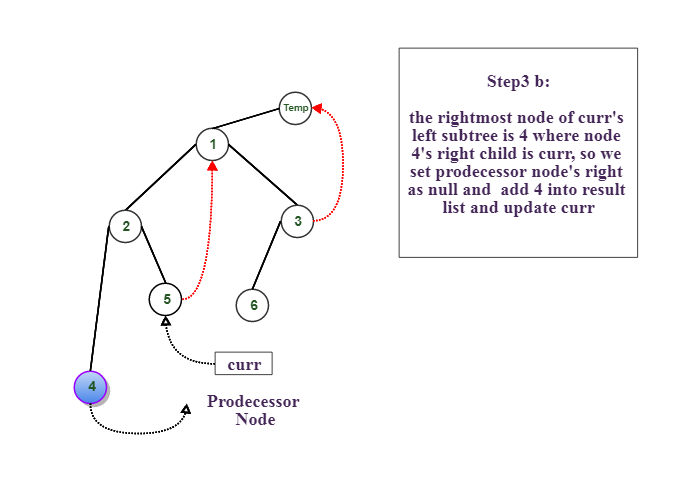
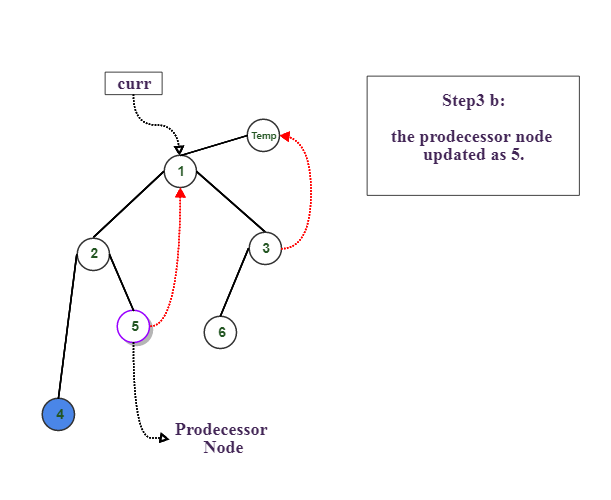
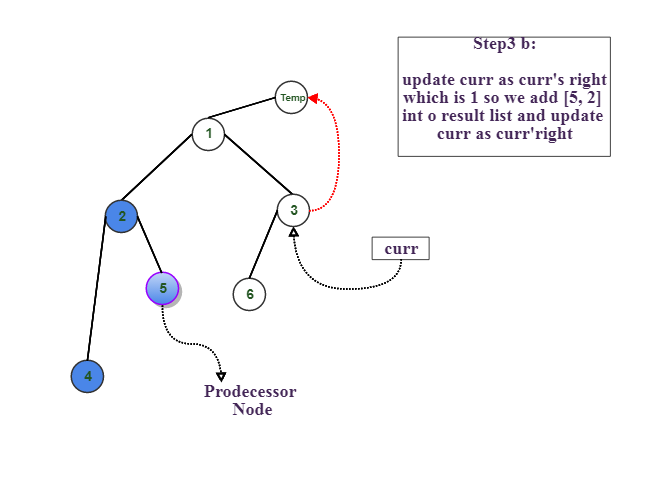
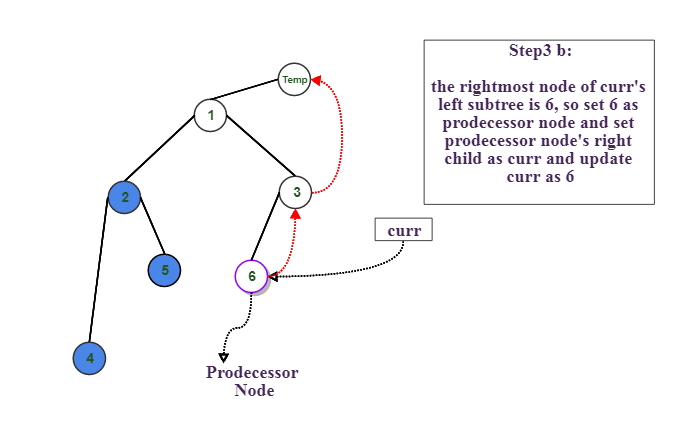
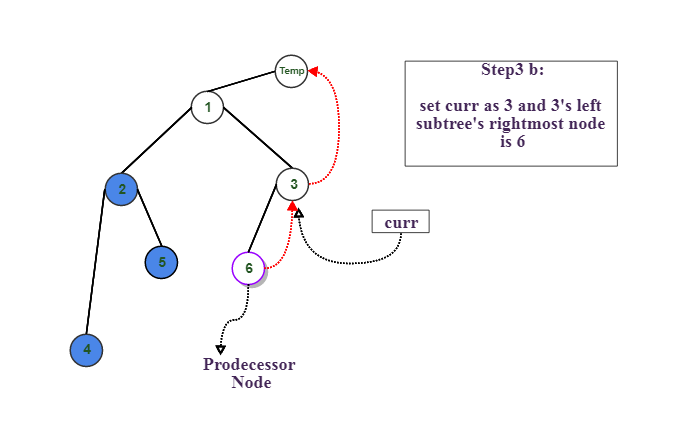
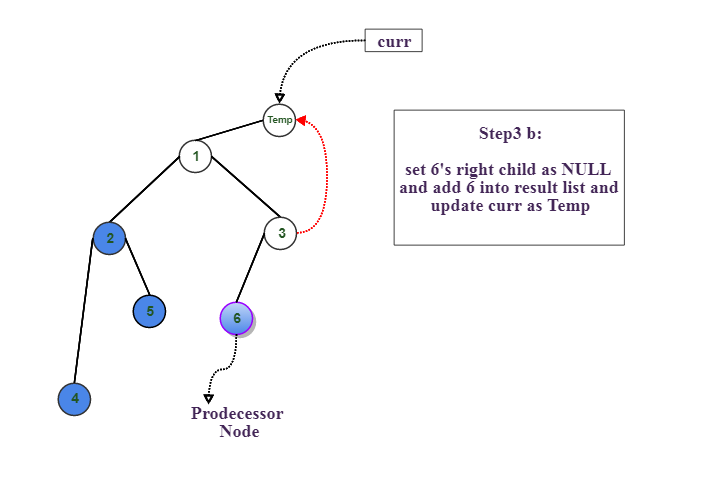
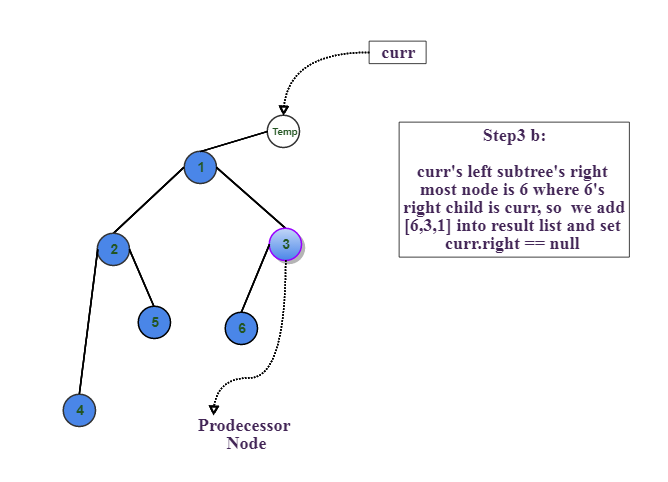
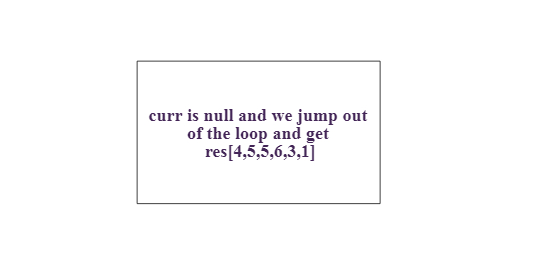
Java
/**
* Definition for a binary tree node.
* public class TreeNode {
* int val;
* TreeNode left;
* TreeNode right;
* TreeNode(int x) { val = x; }
* }
*/
class Solution{
public List<Integer> postorderTraversal(TreeNode root) {
List<Integer> res = new ArrayList<>();
TreeNode temp = new TreeNode(0);
temp.left = root;
TreeNode curr = temp;
TreeNode pro = null;
while (curr != null) {
if (curr.left == null) {
curr = curr.right;
} else {
pro = curr.left;
while (pro.right != null && pro.right != curr) {
pro = pro.right;
}
if (pro.right == null) {
pro.right = curr;
curr = curr.left;
} else {
this.addNode(curr.left, pro, res);
pro.right = null;
curr = curr.right;
}
}
}
return res;
}
public void reverse(TreeNode from, TreeNode to) {
if (from == to) {
return;
}
TreeNode x = from;
TreeNode y = from.right;
TreeNode z = null;
while (true) {
z = y.right;
y.right = x;
x = y;
y = z;
if (x == to) {
break;
}
}
}
public void addNode(TreeNode from, TreeNode to, List<Integer> res) {
reverse(from, to);
TreeNode temp = to;
while (true) {
res.add(temp.val);
if (temp == from)
break;
temp = temp.right;
}
reverse(to, from);
}
}

- 1
- 2
- 3
- 4
- 5
- 6
- 7
- 8
- 9
- 10
- 11
- 12
- 13
- 14
- 15
- 16
- 17
- 18
- 19
- 20
- 21
- 22
- 23
- 24
- 25
- 26
- 27
- 28
- 29
- 30
- 31
- 32
- 33
- 34
- 35
- 36
- 37
- 38
- 39
- 40
- 41
- 42
- 43
- 44
- 45
- 46
- 47
- 48
- 49
- 50
- 51
- 52
- 53
- 54
- 55
- 56
- 57
- 58
- 59
- 60
- 61
- 62
- 63
- 64
- 65
- 66
- 67
- 68
- 69
- 70
- 71
- 72
- 73
- 74
Complexity Analysis
- Time complexity : O(n)
O(n) . To prove that the time complexity is O(n)O(n) ,
the biggest problem lies in finding the time complexity of finding the predecessor nodes of all the nodes in the binary tree.
Intuitively, that complexity is O(nlogn)O(nlogn) , because to find the predecessor node for a single node related to the height of the tree.
But in fact, finding the predecessor nodes for all nodes only needs O(n)O(n) time. Because n nodes in a Binary-Tree has n-1 edges, the whole processing for each edges up to 2 times, one is to locate a node, and the other is to find the predecessor node.
So the complexity is O(n)O(n) .a - Space complexity : O(1)
O(1) . The space complexity of Morris Traversal is O(1)O(1) because it just needs 2 “assisting” pointers.
Video Explanation
Morris Method for Postorder Traversal
Similar Questions
LeetCode 94: Binary Tree Inorder Traversal
Solution 94
LeetCode 144: Binary Tree Preorder Traversal
Solution 144



